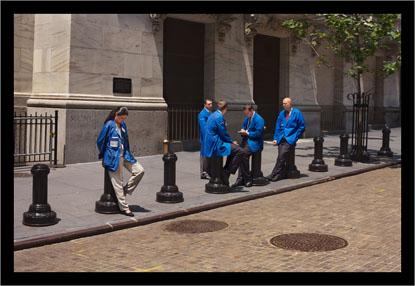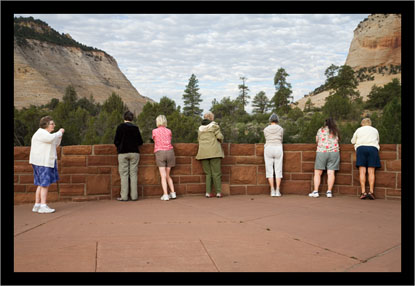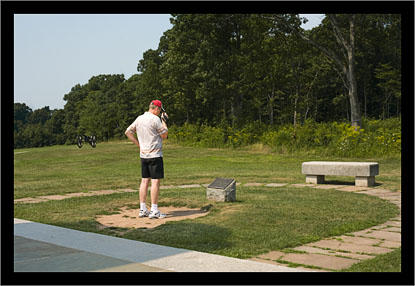
"Smokebreak," Matthew Baum, All rights reserved
Matthew Baum likes "...the idea of meandering around, allowing the camera to lead the way." He says, "Much of my enjoyment ... comes from wandering around and taking pictures of what I see." (all quotes from Humble Arts Foundation's current show of Baum's "Limelight" series). Sunday shooters all over the world would no doubt agree. So what makes Baum's pictures different?
For one thing they succeed in the opportunistic, deadpan "you-can't-make-this-stuff-up" style of 1970s artist-documentarians like Stephen Shore & William Eggleston. But in today's market that's arguably not enough . Baum attempts to expand the genre.
A former architecture student & graduate of SVA, he has taken a conceptual step beyond shoot-it-as-you-find-it work, attempting to graft ideas of set-up theatricality, a la Jeff Wall (see my review) & Philip-Lorca diCorcia, onto his unplanned moments . At SVA they teach the importance of artist statements, & Baum's has written a good one (it actually applies to his work). To "...merge the emotional immediacy of pictures made by observational photographers..." with the "...formal aesthetic and metaphorical content of theater and, consequentially, constructed photographs...", he says, he has developed a post-processing technique that "...distills basic information such as color and surface texture to the essential. They become sculptural..."

"Zion," Matthew Baum, All rights reserved
As a photographer who often tries for the same kind of revelatory formal-informal, incubational stories as Baum, I'm impressed & intrigued. Look at a few in larger size -- e.g. here & here -- to get a better sense of how this subtractive technique focuses the imagination. To give a clearer sense of what's going on, here's a direct comparison of one of my own shots with a similarly-themed one by Baum (p.s. this is not a contest).

"Shiloh," Tim Connor, All rights reserved

"Gettysburg," Matthew Baum, All rights reserved
The difference doesn't knock you over, but it's there (obviously we're dealing with tiny web JPGs here). My only question is how much retouching is necessary for this subtle simplification? My own experience with post-production of grabbed shots is that backgrounds -- the necessary context -- are almost always frustratingly messy. I've been actively working to change my thinking ("Leave it" is my new motto) &, in any case, my retouching skills are only fit for removing the occasional tree branch or distracting reflection. But I keep coming back to a basic fact: photography is not reality. If I'm not doing photojournalism, why am I worried about anything except making the picture work on its own terms?
7 comments:
This is a growing trend to be sure and I can't say I care that much for it. I like all of the roughness and clutter delivered by our generous medium. Baum saying that these pictures become more like theatre, and sculptural, well,maybe, but I think they become more like painting than those two mediums. I'm thinking of the glass like smoothness of David,perhaps. Likewise, for me the work of Loretta Lux calls to mind the paintings of itinerant portrait painters, like the Dutch limners in colonial era America.
"leave it alone" I think that sound advice. Walker Evans said "don't touch a thing", although even he knew that rule wasn't gospel.
Well....sometimes, and it depends....
Sometimes I like the messy reality of a branch that intrudes, or a piece of a person just leaving the frame. Sometimes those are the precise elements that make the image just right for me. Sometimes those are the grace notes.
Unless they actually add value, though, I'm way more likely to yield to my desire to portray a "higher reality" and I will post process out the distractions. Two rationales come to mind.
First, I make images for the same reason I write...to communicate, and I think I approach my imaging in much the same way as I do my writing. In both I aim for a concise, evocative, and well organized "piece." For a written piece, that almost never happens without editing, and knowing how to edit is a most important skill. In creating an image I expect to go through the same kind of process....the idea/shot and then the editing to make it cleaner, clearer, and coherent. Sometimes that clarification can be done in-camera...when time is on one's side and nothing impedes the best view. Sometimes it can only be done afterwards. Although it's a bit of a thrill to be able to do everything in one step, I don't consider a shot that's edited to be any less worthy. For me the worth comes from the strength and clarity of the completed "message."
At an entirely different level, I view the intrusive elements in a "real" photo as artifacts. Even when my goal is more documentary than storytelling, what I want to document is what I actually see. What I actually see (when I'm not consciously composing a picture through a viewfinder) doesn't include the distracting branch or the power line. In fact, my brain automatically weeds out those inessential elements when I am normally engaged with the world, leaving me with image traces that include only the essentials. A camera is not intelligent, depth of field adjustments notwithstanding, and is obliged to see everything in front of it. I'm frankly much more interested in documenting what 'I'/my brain sees than in what a machine/the camera sees.
"...why am I worried about anything except making the picture work on its own terms?"
Exactly.
Unless the photograph is going to be used to portray to someone else an (arguably) accurate depiction of what something looks like, my philosophy is that the sky's the limit in terms of what you do with it.
I see Baum's work, like that of Gregory Crewdson, for example, as hyper rather than smoothed out reality. They're interesting technically. But they don't engage me the same way a painting of the same scene might because they are too perfect in their setup. If Stephen Spielberg were into still photography instead of motion pictures, he'd do these kinds of shots. A little too clean. A little too well composed. A little too well-lighted. The people a little clean and neatly dressed. In short, the photographic version of tableaux vivant.
What's missing from them for me, at least, is "impression," some sense of what the artist is trying to say about the scene he set up. Does he care about these people? Why? Is there drama or comedy? Is something getting ready to happen, or are we seeing the aftermath of something having happened?
Unlike the characters in Crewdson's scenes, who are at least generally playing off of some kind of central real or implied event, Baum's subjects don't seem to be interacting so much as they seem to be merely sharing space in his viewfinder. I may be initially drawn to the geometry of his arrangement of people. But there's little in the scene that draws me back again. Your "Shiloh" photograph, on the other hand, may lack Baum's Speilbergian lighting, but it's at least real. Those people relate to one another. You can almost the mother telling her boys to stand up straight.
As for post processing, I'm not above eliminating power lines, street signs, tree limbs and such. But if I do, it's because I feel they distract from what I want to be the central focus of the image. It's the same way I feel about how some images are better in b&w because the composition is enhanced by the absence of distracting colors.
Thanks for these three thoughtful & eloquent responses.
Chris, you said of the Shiloh pic: "...it's at least real." But it's not. It's a photograph. I think I know what you meant though: it feels real, as much for its imperfections as for any other reason. Your critique is legitimate because, as you state, that's your taste. Mine too -- more or less & so far -- but whether "real" or "Spielbergian", both are styles, illusions.
I found I was attracted to Baum's pix specifically because of the slight weird hint of unreality, which I really couldn't locate at 1st. To give him his due, that's exactly what he's going for. His statement says: "It is my intention that by making the familiar slightly strange the pictures will stir viewers to reconsider what they might see every day if they choose to look more closely."
I just came across this posting with regard to my work. (Yes, I am guilty of googling my own name...sad, I know.) I am flattered and happy that my work has generated this conversation - any conversation! For what it is worth...I do not set up my pictures and I do not use any artificial lighting. There is no setup. My post-production process affects the image, but mostly in that it no longer looks quite the way we are conditioned to expect a photograph to look. In that sense, I hope that my work begins to question our understanding of how photography functions as an arbiter of truth and reality. This is by no means a new issue in photography, but I hope that my work confronts this problem in a unique way that reflects the time in which we live. Thank you for your interest...please get in touch with any questions or comments. mb@matthewbaum.com
I must say that I love his photographs and the composition is really wonderful. While the post-processing does affect the way it's perceived, and notably, it wouldn't work without the initial image being a compelling one.
Unless Baum is putting himself out there as not doing any modifications, or is billing himself as a documentary photographer, then I see his work as simply another form of art. It is another form of photography and one that threatens no other by it's existence, but clearly brings some sense of goodness to some, me included.
I'm all for disussion, but I think it's unnecessary to have controversy, I mean, what's the controversy over exactly? That he post processes? That's like complaining someone uses paint and brush rather than a camera. Art is driven by the vision, not the tool and must be judged on it's result, not on the concerns others have about their sphere of art.
Anonymous, I'm a little bewildered by your comment. My review, such as it was, was positive. I thought I made it clear I like & admire Baum's work. It did use the work as an occasion to raise several questions, but neither my original post nor any of the comments seem to me hostile to the photos or their treatment. I would have called it a conversation.
Post a Comment